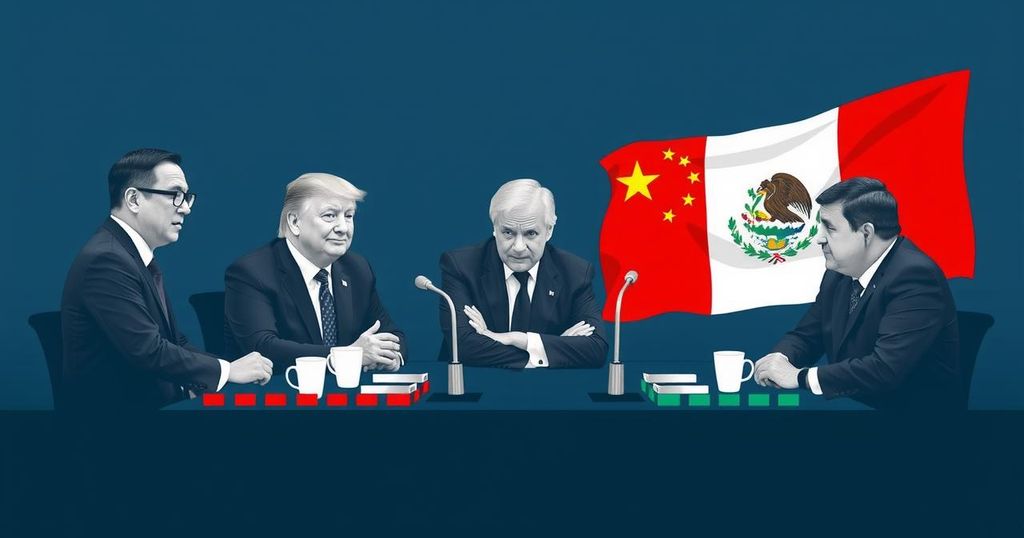President-elect Donald Trump plans to impose significant tariffs on Canada, Mexico, and China in response to illegal immigration and drug trafficking. He proposes a 25 percent tariff on imports from Canada and Mexico and a 10 percent tariff on Chinese goods. The move has elicited concerns from the affected nations and could impact global markets and trade agreements.
In anticipation of his inauguration, President-elect Donald Trump proposed significant tariffs on the United States’ three largest trading partners: Canada, Mexico, and China. These measures are portrayed as a direct response to the inflow of illegal drugs and undocumented immigrants into the country. Trump indicated his intent to implement a 25 percent tariff on all imports from Mexico and Canada, as well as an additional 10 percent tariff on Chinese goods. He emphasized that these tariffs would remain in place until there is a resolution to these border issues, particularly concerning drugs and immigration. Trump’s allies suggest that these tariffs may serve as leverage in negotiations rather than definitive economic policy.
The Canadian and Mexican governments have expressed concern over the potential impact of these tariffs, with Canadian Deputy Prime Minister Chrystia Freeland highlighting the close cooperation between the nations regarding trade and border security. Additionally, Ontario Premier Doug Ford warned that the proposed tariffs would have severe repercussions for workers in both the U.S. and Canada. China reacted by asserting that a trade war would not benefit either party, emphasizing the mutual advantages of economic collaboration between the two nations.
Global markets have already begun to react, with the Canadian dollar and the Mexican peso declining against the U.S. dollar. This downward trend was also observed in other major currencies and stock markets across Asia, underscoring the apprehension surrounding Trump’s tariff proposals. The implications of these tariffs could increase expenses for companies in the affected countries, ultimately leading to higher prices for U.S. consumers. The tariffs, if enacted, could particularly harm Mexico’s automotive sector and Asian technology companies that have established manufacturing bases there.
Trump’s proposed tariffs serve a dual purpose: they aim to address the perceived trade imbalance the U.S. faces with its partners while also attempting to renegotiate existing trade agreements such as the United States-Mexico-Canada Agreement (USMCA), signed by Trump in 2020. Analysts believe the tariffs may indeed signal Trump’s intention to rethink trade relationships to mitigate the persistent trade deficits. As history reveals, Trump has consistently regarded trade deficits as a priority, demonstrating a focus on unbalanced relationships between the U.S. and its trading partners.
In summary, Trump’s ambitious tariff proposals could mark a substantial shift in U.S. trade policy, aimed at coercing Canada, Mexico, and China to address trade imbalances and control drug trafficking and immigration. These moves have sparked considerable concern regarding their potential economic fallout, both domestically and internationally, reflecting an increasingly tumultuous approach to U.S. trade relations.
The proposed tariffs by President-elect Donald Trump reflect a continuation of his administration’s confrontational stance towards trade, particularly with key partners such as Canada, Mexico, and China. Trump’s focus on tariffs is rooted in his longstanding view that the U.S. suffers from unfavorable trade balances, which he perceives as detrimental to American workers and economic sovereignty. His announcement comes with a promise to address issues he regards as critical, such as illegal immigration and drug trafficking, further intertwining trade policy with national security concerns. This approach has significant implications for the economies involved, given the substantial trade flows between the U.S. and these countries.
In conclusion, President-elect Donald Trump’s intention to impose tariffs on Canada, Mexico, and China is framed as a response to immigration and drug issues, reflecting his assertive trade policy agenda. The proposed tariffs could have serious ramifications for global markets and the economies of the involved nations, potentially escalating tensions and leading to retaliatory measures. As these developments unfold, they will likely reshape the economic landscape and complicate existing trade relationships.
Original Source: www.aljazeera.com







